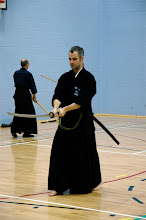I have been training regularly in the last few months, tending to do a bit more koryu than seitei as this is what I have found to be more enjoyable as a general way of training rather than hacking my seitei. I helped out with the teaching at Bideford which was an interesting training experience. It is always very educational to watch others practice (I don't mean that with any sense of irony) especially when it looks like they are having problems. To understand how people imagine forms should be enhanced can make one question one's own understanding and reasoning behind things like power emphasis, timing and balance. I saw many people who were trying to cut with the right hand just above and in front of the forehead. Naturally this puts all the work responsibility on the elbows and wrists which are not by any means the most powerful muscle groups in the body, nor is it conducive to generating large cuts and some degree of momentum. I'm not sure why people feel it necessary to cut this way. Pass someone an axe or a sledgehammer and I'm certain they will use it far more expediently than the sword. I'm not suggesting any infallibility in my own cutting technique only some genuine wonderment as to what image people are holding.
Getting back to the main topic of my 6th dan grading preparation, on Tuesday I started putting in place moves to try the grading again in Bologne in June and there is a part of me that is genuinely excited by the prospect of going to a different type of budo event for this. I know that quite a few of my friends and peers are also going so it will hopefully be an enjoyable time. Members of the Trust! Facebook group will know my feelings about the grading politics themselves, I will keep this blog free of them for now.
With this new fire in my tail I went back to my seitei training last night. I have a lot of things to work on in the next couple of months of prep time:
- Control of the kissaki during ochiburi.
- Keeping my shoulder down in nukitsuke.
- Developing flexibility back into my toes and feet.
- Losing 5kg of bodyweight.
- Balance at the end of Ukenagashi.
- Almost all of Kesagiri.
- Sayabiki/Sayabanare in Morotezuki.
- Furikaburi in Ganmenate.
- Intensity of Sogiri.
- Not cutting my arm off in Nukiuchi.
- Shortening my hakama (!)
In addition I want to do some academic study and ensure I know all the grading points for all the katas in the seiteigata (who does know them all?). I have translated and represented them several times but it's sometimes difficult to keep them all in the head.
I had some thoughts earlier this week concerning Junto/Kaeshaku that I wanted to get onto the blog but it will have to wait for another time. Alas.




Hi Andy,
ReplyDeleteDo you have any tips on developing flexibility of the toes and feet?
Also, can you clarify shortening the hakama? Is the guideline for hakama in iaido same as kendo? Or shorter?
Hi David
ReplyDeleteRegarding the toes and feet I have discovered for myself a few bits and pieces:
1. They need to be "manually" stretched before training i.e. sitting down and using your hands to wiggle and stretch each toe for about 30 seconds each. When the toes are bent forwards then I give a little massage to the top of the toe where the tendons become a bit tight.
2. The toes get "cold" i.e. tight very easily and quickly when they are not being used. If I move from tate hiza kata to standing kata for just a few minutes then they often need another little massage and stretch before doing tate hiza again.
3. I have a complete hip to toe stretch routine which I will try to get into the next blog as it requires graphics.
4. A physio friend of mine recommended practicing picking up tissues with my toes when sitting down at home. I haven't tried this yet in case there are any hidden cameras in my house but I understand that it builds up important strength in the delicate muscles in the feet and toes.
I do believe that just as many martial artists use stretches to develop long term strength and flexibility in muscles (and to a lesser degree in joints) that the feet are of utmost importance to do the same in iaido. No other martial art or sport that I know of puts as wide a range of stresses on the feet. We should consider these leg-ends to be the most important part of our body in iaido IMHO.
Regarding the hakama length, this was a bit of crass comment after last year's iaido grading (or massacre as it has become to be known). If the kendo regulation is that the hakama should end at the ankle bone then it is the same as iai. A couple of things to consider though:
1. I think a lot of kendoka, for very good reasons, wear their hakama slightly higher off the foot. With the very sharp movements in various directions in kendo I guess it is very important that it doesn't get caught up in the feet.
2. When doing iaido, the performance of the katas with a sword weighing down on one side only, as well as the saya being pulled around inside the obi tends to a) drop the hakama down during training and b) drop it more on the left hand side. With this in mind I think that the hakama length needs to be considered, measured and cut within 5mm accuracy (ish) - especially if one's grading depends on it.
Hope that helps.
Andy